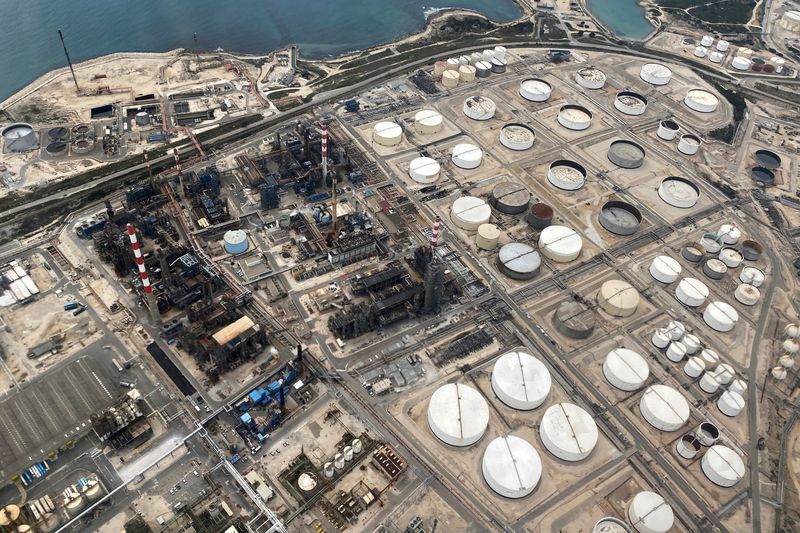Commodities
Oil slips after rally last week on Middle East, tight supply


© Reuters. FILE PHOTO: Storage tanks are seen at the Petroineos Ineos petrol refinery in Lavera, France, March 29, 2022. Picture taken March 29, 2022. REUTERS/Benoit Tessier/File Photo
By Natalie Grover
LONDON (Reuters) -Oil prices slipped on Monday as investors indulged in some profit-taking after both benchmarks ended last week about 6% higher on Middle East tensions and as refining outages squeezed refined products markets.
futures were down 89 cents, or about 1.1%, at $81.30 a barrel, while U.S. West Texas Intermediate crude futures slipped 83 cents, also about 1.1%, to $76.01 a barrel at 1239 GMT.
Last week, the major forces underlying the rally were the persistent threats to shipping in the Red Sea, Ukrainian strikes on Russian refineries and U.S. refinery maintenance, Tamas Varga of oil broker PVM told Reuters.
This has led to scarce availability of products, particularly in the middle of the barrel, he said.
“These factors have not subsided yet – and for this reason, I believe that what we see at the moment is only a retracement.”
Logistics disruptions in the Red Sea continued on Monday, with Yemen-based Houthis saying they had targeted a cargo ship in the Red Sea, which they claimed was American.
Shipping trackers said the Marshall Islands-flagged ship was Greek-owned, while analysts said it had been heading to Iran with a corn cargo.
The Houthis have targeted shipping with drones and missiles since November in solidarity with Palestinians in Gaza. The United States has led retaliatory strikes on Houthi missile sites since January.
The Houthis have since said they will target ships not just connected to Israel, but also the U.S. and Britain.
In other supply news, Saudi Arabia’s energy minister on Monday said the reason behind the Kingdom’s recent decision to halt its oil capacity expansion plans was the energy transition, adding that the kingdom has plenty of spare capacity to cushion the oil market.
In terms of non-OPEC production, however, a potential uptick in U.S. production emerged, with U.S. energy firms increasing oil and rigs to their highest since mid-December.
Still, demand concerns fester.
A U.S. Federal Reserve official said she had no interest in recommending an interest rate cut, adding to the chorus on further reining in inflation.
On the other side of the Atlantic, European Central Bank officials soothed markets by suggesting cuts were on the table sooner rather than later.
Higher interest rates slow economic growth, dampening oil demand.
U.S. inflation data is expected on Tuesday, while British inflation data and euro zone GDP should land on Wednesday.
Meanwhile, France’s TotalEnergies (EPA:) CEO Patrick Pouyanne said he does not see peak oil demand in the numbers, adding “we should exit debate about peak oil demand, be serious, and invest”.
Paris-based oil forecaster the International Energy Agency (IEA), which represents industrialised countries, predicts oil demand will peak by 2030, undercutting the rationale for investment.
But OPEC believes oil use will keep rising over the next two decades.
Commodities
Oil prices rise; U.S. crude inventories plunge, Russia-Ukraine truce eyed
Commodities
India’s Reliance to stop buying Venezuelan oil over US tariffs, sources say
Commodities
Oil prices climb on Venezuela supply worries

 Forex3 years ago
Forex3 years agoForex Today: the dollar is gaining strength amid gloomy sentiment at the start of the Fed’s week

 Forex3 years ago
Forex3 years agoUnbiased review of Pocket Option broker

 Forex3 years ago
Forex3 years agoDollar to pound sterling exchange rate today: Pound plummeted to its lowest since 1985

 Forex3 years ago
Forex3 years agoHow is the Australian dollar doing today?

 Cryptocurrency3 years ago
Cryptocurrency3 years agoWhat happened in the crypto market – current events today

 World3 years ago
World3 years agoWhy are modern video games an art form?

 Commodities3 years ago
Commodities3 years agoCopper continues to fall in price on expectations of lower demand in China

 Economy3 years ago
Economy3 years agoCrude oil tankers double in price due to EU anti-Russian sanctions























